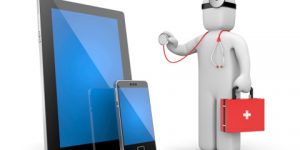ICTpost mHealth Bureau

New provisional research indicates that health IT can help hospitals focus on quality care improvement, reduce mortality rates and boost patient satisfaction.
A?study published in?Vaccine?has tried to quantify just how much the Bar coding technology could save healthcare systems. From 2011 to 2023, net economic benefits were forecasted to be $310 million to $334 million. Researchers reached the figure after weighing up the financial effects of more efficient documentation and other factors.
Bar coding technology
Over a period of time there has been an increase in the use of bar code readers. Our most common experience with the barcode readers is during billing at most of the shopping stores. But its usage is not confined to the consumer industry, it has been in use in other industries as well including the healthcare.
Barcode readers are a new concept in healthcare in India and are not very extensive so far, but it’s bound to increase in the days to come. It is mainly used wherever there is a movement of materials involved, to the extent that a medicine being given to the patient can be bar coded and then read through barcode reader for accuracy as to the drug type, batch no, expiry etc.
Research has shown that errors that occur earlier in the medication process are more readily detected (~50% are prevented during the ordering stage) while very few (< 2%) are caught at the administration stage. further, it has been noted that more than one third of medication errors occur at the latter stage. Because of the relatively high proportion of errors and the lack of success preventing them, error reduction strategies targeted at the administration stage have recently received significant attention from providers, specialty societies, and regulatory agencies.
An emerging information technology designed to address medication administration errors uses barcodes on both the medication and patient that are scanned at the point-of-care (POC) before administration. At its most basic level, barcode-assisted prevention of medication administration errors is predicated on verifying the ?5 rights; the right patient, right drug, right dose, right route, and right time.
Medication Error
The National Coordinating Council for Medication Error Reporting and Prevention (NCCMERP) defines a medication error as any preventable event that may cause or lead to inappropriate medication use or patient harm while the medication is in the control of the healthcare professional, patient, or consumer?. By definition, these errors can occur at any stage in the medication process, which includes prescribing, order communication, product labeling, packaging, compounding, dispensing, distribution, and administration. Various information technologies have been applied to reduce errors throughout the medication process.
In the Bar Coded Medication Administration or BCMA, the patient’s records are documented electronically. In the system the order for medications are put by the Physician on the basis of which the pharmacy sends the doses required for the next 24 hours. The drugs dispensed are billed by reading the barcode on each medicine, which includes the Generic salt in medicine, brand name of medicine, batch no and expiry date. The barcode of Generic also enables alerts on allergy reactions.
Challenges in the adoption
The packaging and standard bar codes on medicines and equipment need to be standardized to make reduce the costs of Bar Code Administration and improve the usage like in consumer industry.. Healthcare industry faces a few challenges in the use of Barcode technology, principal among them, absence of barcode on drugs, bulky devices hinder access to bed ridden patient, absence of barcode standard for healthcare in India.
Future
All the new applications are being developed today in order to improve the levels of patient care and safety. Administering medication to the patient as part of treatment also involves a risk of errors, which makes the difference between life and death for the patient. BCMA following the principle of 5 Rights definitely reduces the chances of medication errors. For the delivery of safe healthcare, bar code technology provides a way to track actions and material involved in the care of the patient. The technology helps in tracking material from procurement to consumption/administration.
Additionally, we expect the mobile devices to mature to a level to read the barcodes on vendor packaged medicines. We may then have a barcode reader for medications in every mobile phone and tablet.
Barcode Technology and mHealth
Mobility drives many aspects of our lives today. Retailers have noticed, and are leveraging that driver to increase sales. During peak shopping seasons, consumers see QR codes offering them deals and coupons. Super-savvy shoppers seek ways to make price comparisons while in-store.
Since these consumers have mobile devices?like tablets and smartphones already in their hands, it makes sense to incorporate barcode technology into those devices. Consumers want price comparisons, deals and coupons at their fingertips, and barcode technology and hardware is the solution to that?both for the retailer and the consumer.
Things move fast today?and manufactures have to keep up. The more mobile and untethered a manufacturer’s warehouse or sales force can become, the more efficient they can be.
In light of that, manufacturers want to adopt real-time inventory management solutions that are not only easy to use, but also wireless. Mobile solutions will allow manufactures to work faster and more efficiently, thus staying ahead of their competition.







